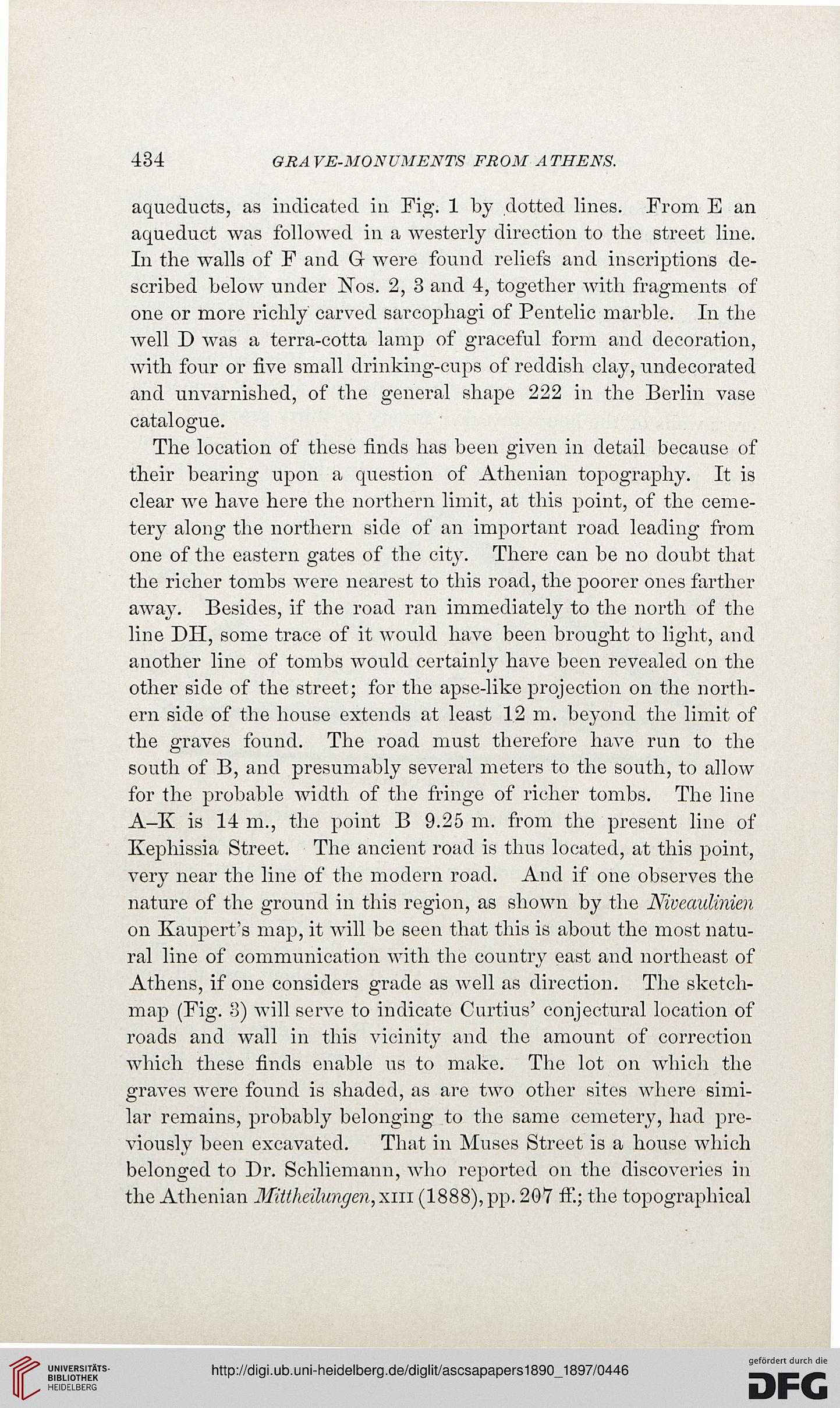434
GRAVE-MONUMENTS FROM ATHENS.
aqueducts, as indicated in Fig'. 1 by dotted lines. From E an
aqueduct was followed in a westerly direction to the street line.
In the walls of F and G were found reliefs and inscriptions de-
scribed below under Nos. 2, 3 and 4, together with fragments of
one or more richly carved sarcophagi of Pentelic marble. In the
well D was a terra-cotta lamp of graceful form and decoration,
with four or five small drinking-cups of reddish clay, undecorated
and unvarnished, of the general shape 222 in the Berlin vase
catalogue.
The location of these finds has been given in detail because of
their bearing upon a question of Athenian topography. It is
clear we have here the northern limit, at this point, of the ceme-
tery along the northern side of an important road leading from
one of the eastern gates of the city. There can be no doubt that
the richer tombs Avere nearest to this road, the poorer ones farther
away. Besides, if the road ran immediately to the north of the
line DII, some trace of it would have been brought to light, and
another line of tombs would certainly have been revealed on the
other side of the street; for the apse-like projection on the north-
ern side of the house extends at least 12 m. beyond the limit of
the graves found. The road must therefore have run to the
south of B, and presumably several meters to the south, to allow
for the probable width of the fringe of richer tombs. The line
A-K is 14 m., the point B 9.25 m. from the present line of
Ivephissia Street. The ancient road is thus located, at this point,
very near the line of the modern road. And if one observes the
nature of the ground in this region, as shown by the Niveaulinien
on Kaupert's map, it will be seen that this is about the most natu-
ral line of communication with the country east and northeast of
Athens, if one considers grade as well as direction. The sketch-
map (Fig. 3) will serve to indicate Curtius' conjectural location of
roads and wall in this vicinity and the amount of correction
which these finds enable us to make. The lot on which the
graves were found is shaded, as are two other sites where simi-
lar remains, probably belonging to the same cemetery, had pre-
viously been excavated. That in Muses Street is a house which
belonged to Dr. Schliemann, who reported on the discoveries in
the Athenian Mittheilungen, xiii (1888), pp. 207 ff.; the topographical
GRAVE-MONUMENTS FROM ATHENS.
aqueducts, as indicated in Fig'. 1 by dotted lines. From E an
aqueduct was followed in a westerly direction to the street line.
In the walls of F and G were found reliefs and inscriptions de-
scribed below under Nos. 2, 3 and 4, together with fragments of
one or more richly carved sarcophagi of Pentelic marble. In the
well D was a terra-cotta lamp of graceful form and decoration,
with four or five small drinking-cups of reddish clay, undecorated
and unvarnished, of the general shape 222 in the Berlin vase
catalogue.
The location of these finds has been given in detail because of
their bearing upon a question of Athenian topography. It is
clear we have here the northern limit, at this point, of the ceme-
tery along the northern side of an important road leading from
one of the eastern gates of the city. There can be no doubt that
the richer tombs Avere nearest to this road, the poorer ones farther
away. Besides, if the road ran immediately to the north of the
line DII, some trace of it would have been brought to light, and
another line of tombs would certainly have been revealed on the
other side of the street; for the apse-like projection on the north-
ern side of the house extends at least 12 m. beyond the limit of
the graves found. The road must therefore have run to the
south of B, and presumably several meters to the south, to allow
for the probable width of the fringe of richer tombs. The line
A-K is 14 m., the point B 9.25 m. from the present line of
Ivephissia Street. The ancient road is thus located, at this point,
very near the line of the modern road. And if one observes the
nature of the ground in this region, as shown by the Niveaulinien
on Kaupert's map, it will be seen that this is about the most natu-
ral line of communication with the country east and northeast of
Athens, if one considers grade as well as direction. The sketch-
map (Fig. 3) will serve to indicate Curtius' conjectural location of
roads and wall in this vicinity and the amount of correction
which these finds enable us to make. The lot on which the
graves were found is shaded, as are two other sites where simi-
lar remains, probably belonging to the same cemetery, had pre-
viously been excavated. That in Muses Street is a house which
belonged to Dr. Schliemann, who reported on the discoveries in
the Athenian Mittheilungen, xiii (1888), pp. 207 ff.; the topographical




